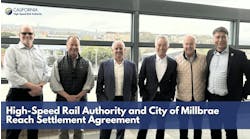OP-ED: LIRR service disruptions ahead with upcoming Amtrak East River Tunnel work
Amtrak's recent award of a construction contract to Skanska E-J Joint Venture for work on repairs to the East River Tunnels that were subject to flooding by Super Storm Sandy in 2012 that resulted in significant damage is only the start of what will be a long journey facing Long Island Rail Road (LIRR) commuters before completion. The East River Tunnel was opened in 1910 and is 114 years old today with four tubes connecting New York Penn Station with Queens, N.Y., and beyond.
It connects Amtrak intercity trains leaving Manhattan on the Northeast Corridor (NEC) north to Boston, Mass., and LIRR commuter services east to Long Island or into the Queens Sunnyside Yard. Amtrak and New Jersey Transit (NJ Transit) trains are stored, cleaned and turned around to reverse directions before traveling back to New York Penn Station and on to New Jersey.
In June 2016, New York Sen. Chuck Schumer (D) proclaimed that he obtained funding from the Federal Transit Administration (FTA). The FTA grant that year provided $432 million in Super Storm Sandy funding to the New York Metropolitan Transportation Authority (MTA) for repairs to the East River Tunnels. More than eight years later, there is little evidence that these funds have been used for their original intended purpose.
In the interim, the cost of work has increased 300 percent to $1.6 billion. With construction work starting in 2024, 12 years after damages incurred by Super Storm Sandy in 2012, there is no guarantee that repairs to the two most damaged tunnels will be completed by 2027.
With Amtrak removing one of four tunnels at a time 24/7, to preserve existing service, some LIRR rush hour trains will be canceled or combined. Until this work is over, it will be difficult to guarantee safe and reliable on time service to Penn Station for commuters. The LIRR needs to develop a new Penn Station service plan and make it public prior to Amtrak initiating this work.
Amtrak resources are committed to many projects along the NEC between Washington D.C. and Boston, Mass., for years to come. Three of these in the Metro New York area include the $1.6 billion New Jersey Northeast Corridor Portal Bridge, $3.1 billion MTA Metro North Rail Road Bronx East Penn Station Access and $16.8 billion Gateway Tunnel Phase One. This does not include ongoing routine maintenance at Penn Station Newark, Penn Station New York, Hudson and East River tunnels used by the LIRR, NJ Transit, Amtrak and starting some time in 2028 Penn Station by Metro North Rail Road, $2 billion Maryland Susquehanna River Bridge, $4.7 billion 1.4 mile for the Baltimore Potomac Tunnel, $827 million Connecticut River Bridge, other stations, tracks, bridges, tunnels, power and facilities along the NEC.
How can Amtrak provide sufficient numbers of employees to work on these key state of good repair and system expansion projects while supporting work on the East River Tunnel project at the same time? The Amtrak Inspector General Report on the Northeast Corridor New Jersey Portal Bridge project noted that "Amtrak staffing of the project has at times been insufficient." This may be an early warning of problems ahead.
The only way to validate that Amtrak has adequate resources is for an outside independent review of their current 2024 and future Annual Track Outage and Force Account (in house track, signal maintainers and other specialized craft employees) plans. This is the only way we could validate that they have the resources to support future East River Tunnel work, along with all the other major capital projects in the Metro New York area and NEC.
We would also need to see the detailed construction schedule submitted by the winning construction contractor, Skanska E-J Joint Venture. It will have to be reviewed and approved by Amtrak. The schedule would provide the weekly, monthly and yearly detailed construction project interim milestones, along with sequencing of work and critical path that justify the promised 2027 completion date.
Don't be surprised if over time, the project completion date slips into 2028 or 2029. The budget may also increase. There will also be the inevitable contract change orders during construction. They may be due to unforeseen site conditions, last minute requests by Amtrak operations, maintenance or other departments, including LIRR and NJ Transit.
Construction contractors sometimes submit delay claims for additional financial reimbursement. These claims may be based upon insufficient and timely track access necessary to perform required or additional work not included in the original contract.
Amtrak has previously stated that it will require one of the two tunnels damaged by Super Storm Sandy to be out of service at a time to advance project work. The other two tunnels will also need work to bring them up to a state of good repair. With only three of four tunnels available, there will be a 25 percent reduction in Penn Station access and capacity.
This directly contradicts Schumer's statement in 2016 "that all 453 Amtrak and LIRR trains that utilize the East River Tunnels will continue to run on time during reconstruction." Did he also forget NJ Transit? They, along with Amtrak, need significant access to move equipment to and from the Sunnyside Yards via the same tunnels. This facility is used by both Amtrak and NJ Transit for mid-day and overnight storage to position equipment for rush hour and off-peak service.
Three of four tunnels running inbound mornings and evening rush hours have tight spacing between trains. One tunnel is shared by the LIRR, NJ Transit and Amtrak for reverse train movements, with equally tight spacing during rush hours. Penn Station is currently operating at 100 percent capacity during rush hours.
If one of the four tunnels is temporarily out of service, the result is numerous delays, cancellation and combining of trains. The West Side Penn Station yard is used by LIRR for mid-day storage of trains. During the evening east bound rush hour, the LIRR runs out of equipment from this facility. Full east bound evening peak service is dependent upon west bound trains arriving at Penn Station. This equipment is turned around to make a second trip east bound.
Amtrak initiation of East River Tunnel rehabilitation starting in 2024 will result in one of four tunnels being removed from service 24/7. If a train stalls in one of the three remaining tunnels, thousands of commuters will be late.
How could Schumer's promise eight years later of no service disruptions or cancellation of any trains still be valid given all of these issues?
To preserve existing service, it is obvious some LIRR rush hour trains will be canceled or combined. This results in overcrowded trains with insufficient seating capacity. Some riders end up standing in the vestibules and aisles. Conductors are unable to walk through trains and check tickets.
Until this work is over, it will be impossible to guarantee safe and reliable on time service with the same current level of service, including a seat, during morning and afternoon peak trips to and from Penn Station for LIRR commuters.
Reduced East River tunnel capacity also makes it difficult to add previously promised new services, which includes Metro North Rail Road East Bronx New Haven line Access to Penn Station via the Hell Gate Bridge and 40 percent overall increase in reverse peak service as a result of East Side Access to Grand Central Madison.
Both Amtrak and NJ Transit need access to the Queens Sunnyside Yards via the East River tunnels to support their own respective planned service increases. Going from four to three available East River tunnels can only result in a significant capacity reduction. This translates to no increase in existing or new services until work on all four East River tunnels is completed.
The LIRR 1960's motto "Line of the Dashing Dan" should be changed to "Line of the Slow Moving Sloth" when it comes to completing East River Tunnel repairs as a result of damages from 2012 Super Storm Sandy 15 years later in 2027.

Larry Penner
Larry Penner is a transportation advocate, historian and writer who previously served as a former director for the Federal Transit Administration Region 2 New York Office of Operations and Program Management. This included the development, review, approval and oversight for billions in capital projects and programs for New Jersey Transit, New York Metropolitan Transportation Authority, NYC Transit bus, subway and Staten Island Railway, Long Island and Metro North railroads, MTA Bus, NYCDOT Staten Island Ferry along with 30 other transit agencies in New York and New Jersey.






